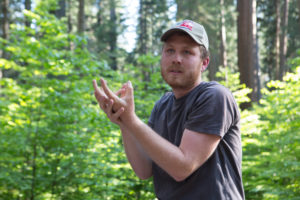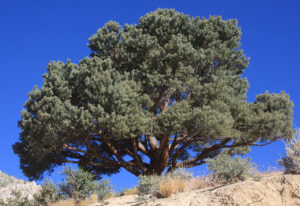
Paul Burow: Forests of Meaning
Paul Burow served as a BKF Fellow in 2012-2013 and was paired with Lucy Blake, a MacArthur “Genius” known for her talent in bringing together unlikely partners to work together on large-scale environmental initiatives. Lucy mentored Paul in her role as President of the Northern Sierra Partnership (NSP), which is a collaborative initiative to conserve, restore, and enhance the magnificent natural landscape of the northern Sierra Nevada, and to build the foundation for sustainable rural prosperity.
Born and raised in California, Paul has a deep connection to the state, especially the Sierra Nevada region, where he spent many happy summers as a child and where he still lives part of the year.
Since completing his fellowship, Paul has been working on his PhD at Yale University in a combined degree program offered by the School of Forestry & Environmental Studies and the Department of Anthropology. Currently, his fieldwork is based out of the University of California’s White Mountain Research Center in the Eastern Sierra town of Bishop. Although most people think of “Lake Tahoe” or “Yosemite” when they picture this region, Paul is interested in drawing attention to other California landscapes that have not captured the public attention in the same way.
Paul’s current project examines the political and cultural life of piñon forests in North America’s Great Basin, focusing on a borderland region that conjoins California and Nevada, two states that are tightly linked historically and in the present. As both a historical and contemporary ethnographic project, it looks at how the piñon pine and its iconic pine nuts tell a story of entanglement among humans, plants, and animals. He is particularly interested in the question of belonging and what it means to different communities, human and non-human, given complex histories and ongoing struggles revolving around environmental change, Indigenous rights, and rural economies in western Nevada and eastern California.
We asked Paul to tell us more about his thesis and why piñon-juniper forests make for an exceptionally rich area of study:

Piñon pine (Pinus monophylla) is a tree native to the Great Basin along with its common companion species, Utah juniper (Juniperus osteosperma). Piñon-juniper forests cover 100 million acres (an area equivalent in size to California) of the U.S. Southwest. These forests have served an important role in the political and environmental history of the region, fueling mining and settlement in the 19th century as they provided raw material for smelters, building construction, and fuel wood. They were further cleared in the 20th century for agriculture and ranching. The beginning of the 21st century saw a renewed effort to remove piñon-juniper woodlands as part of ecological restoration projects to protect the threatened sage grouse (Centrocercus urophasianus) by extirpating trees believed to be encroaching on sagebrush shrublands. But for many, these forests are important and highly valued. Piñon-juniper woodlands are notable for their cultural valence to Indigenous and other local communities. These woodlands figure prominently in ecological ideas about Indigeneity and belonging. This project looks at the cultural and ecological politics shaping debates over who and what belongs on the land during an era of precarious life under the disturbances of capitalism, climate change, and settler colonialism.

Piñon pine barely surfaces on the North American West’s register of charismatic flora, but the tree is iconic for its production of pine nuts, though the food product is often dissociated from the image of its source. Pine nuts, the edible seed produced by piñon pine, are notable for their quality as a food. Long an important food source to Numa (Northern Paiute), Washiw (Washoe), and Newe (Shoshone) peoples in the western Great Basin, the pine nut also resonates with subsistence, cultural, spiritual, and medicinal values. Pine nut collecting is also a common practice among rural non-Indigenous residents of the region. Despite having widespread piñon pine woodlands, more than 80% of commercially sold pine nuts in the United States are imported from abroad—mostly from China, Russia, South Korea, and Pakistan. Although some small commercial pine nut operations exist in the U.S. West, the millions of acres of piñon-juniper woodlands, almost exclusively located on public lands managed by the Bureau of Land Management and U.S. Forest Service, are mostly left to local, non-commercial foraging and the numerous species of birds and mammals that subsist on and sustain piñon forests. Piñon-juniper woodlands are among the most prevalent ecosystem types of the region. These woodlands are notable as one of the most climate-resilient forest ecosystem types in North America. Ecological scientists and U.S. federal land managers are grappling with vegetation change resulting from climate change and various forms of anthropogenic disturbance (exclusion of fire, introduced species, grazing, urban development, and industrial resource extraction). One of the major forms of vegetation change is taking place in piñon-juniper woodlands, which are seeing changes in distribution and density. This includes both expansion and contraction, and is highly variable depending on the site conditions. At the same time, sage grouse are impacted by all of these changes, especially in the California/Nevada borderlands region, due to urban development, vegetation change, and other factors. While piñon-juniper woodlands have long been a subject of ecological study, they have not received much attention for their political and cultural history.
